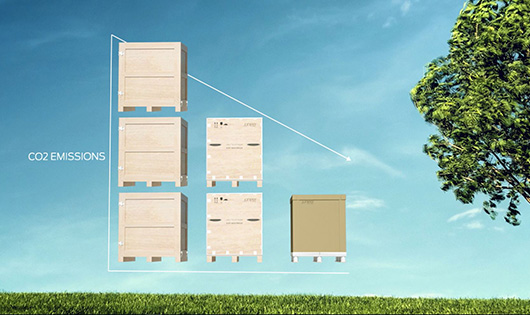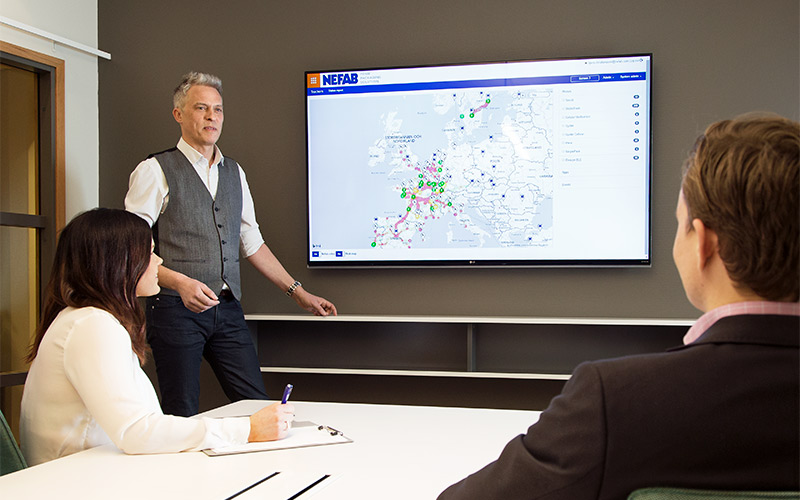NEWS & INSIGHTS
SOLUTIONS FOR SUSTAINABLE SUPPLY CHAINS
Securing a Sustainable future
Taking care of the world’s resources responsibly should be part of every company’s culture. In logistics, this can be achieved through optimizing supply chains, and more importantly, by improving packaging solutions.
Whether it is aligning sizes to the mode of transport or introducing sustainable materials, all efforts are needed to secure a sustainable future. However, the efforts need to be well thought through to avoid causing environmental issues instead of solving them. Therefore, it is important that we look at sustainability in a broader sense.
What is our goal?
Let us start with the result we want to achieve. Goals such as reducing global warming, good stewardship of our finite resources, preventing packaging from ending up in the environment as waste, or respecting the fragile balance in our ecology all need to be economically feasible. Goals linked to sustainability are already very broad and the approaches we take to them will affect them in different ways.
Are all approaches sustainable?
A well-known producer of a biodegradable plastic wanted to reach higher technical demands. So, a traditional plastic was added in small quantities to a bio based, biodegradable plastic. The resulting plastic still passes all biodegradation tests and is still viewed as bio based, but now, it will need oil, a finite raw material, and higher levels of CO2 to produce it compared to traditional plastic. One could question if it is a sustainable material at all. Another example is biofuel. Years ago, biofuel was introduced and farmland converted to produce it. The result was so successful that farmers were switching from growing less profitable food grade crops to highly profitable industry grade crops, leading to food shortages. This is now being corrected at greater expense for farmers and for people needing the food supplies.
One might argue that these sustainable efforts are bad and we should stop them altogether. But is that correct? The first example has led to partially biodegradable materials being used in more demanding situations. The biofuel example has enabled the industry to add bio content to traditional gasoline from other sources that won’t influence food supplies. In other words, making mistakes doesn’t mean we can’t learn from them. What we should make ourselves aware of are the possible consequences by not just accepting any sustainability claim as being good.
Defining Targets
To reduce the complexity of the topic “sustainability,” we should choose a clearly defined target and then investigate the implications of that target. One of the main goals that comes back again and again is related to our climate and the global warming effect. No-one would deny that it would be favorable to reduce any effect we may have on the climate.
Global Warming - Carbon Dioxide.
One of the main aspects in global warming potential is the carbon footprint, or CO2. In terms of packaging and logistics, CO2 is created while the packaging is manufactured, transported and at the end-of-life. The impact can be calculated by a life cycle analysis program. Some packaging companies have developed their own software, giving them the ability to immediately compare which solutions have the lowest CO2. These programs can measure and show the significant CO2 savings that can be reached, and equally important, also have a positive economic effect by:
- Utilizing the full surface and height of the transport eg: use the whole pallet
- Not using unnecessary packaging materials eg: avoid stretch wrap when it isn’t needed
- Avoid unnecessary transport if possible eg: ship materials directly from producer to end-user
- Reduce weight or volume for air transport eg: use lighter pallets
- Using returnable flows and packaging eg: use plastic boxes or collars and packaging pools
Sustainable solutions and Materials
Why do so many “green” or “sustainable” solutions cost so much? The answer is simple...
Reuse – Returnable Solutions
Being sustainable and reducing costs can go hand in hand, even with an approach like a returnable flow and reusable packaging. One of the most underrated sustainable improvements is one of the oldest: logistics with a returnable packaging flow. Often this flow needs sturdier packaging and more transport, but in most cases, this flow will reduce CO2 significantly because you don’t have to manufacture the package over and over again. Additionally, if the solution is collapsible, it can also be cost efficient for return transport and storage. The effective CO2 reduction can easily be calculated in both cases. Even if an expendable packaging seems to be cheaper in the short term, it will always be beaten by a returnable solution in the long run.
Evolving current solutions and Exploring new materials
Why do so many “green” or “sustainable” solutions cost so much? The answer is simple - economy of scale. Any new product introduction is more expensive. You start small. Sometimes the companies involved are small. The production volume is low. Capital investments need to be considered. These are normal new product introduction aspects that can sometimes be avoided or overcome quite fast. A very good example of this is a Swedish furniture company. They continually focus on reducing their packaging using the footprint of their transport and storage and all the points mentioned earlier. This way they save cost and reduce CO2. They continuously work to find novel ideas like only using fiber based packaging, reducing pallet height and changing their pallet jacks. We aren’t all as big as them but we can reflect and try to introduce these approaches ourselves. Another example is the automotive industry where a German car manufacture introduced collision braking, which soon led to that other car companies followed their lead. The car manufacture probably invested most in this but also gained green kudos from it. If other industries work in this way, why can’t we?
The above-mentioned approaches are currently available and accessible to us all. But there are also new sustainable materials coming and again, they need to be evaluated as broadly as possible. These materials are divided into three main categories: Bio based, biodegradable and recyclable. This doesn’t necessarily mean that being in one category implies that they are also part of the others. A bio based material can be non-recyclable because of the material or because we have no recycling system in place.
a. Bio based Materials.
A lot of plastic producers are expanding towards bio based plastics. This can be done by using oil from a natural source that can be re-grown. This makes most sense when the natural source won’t compete with food sources and even more preferably when it comes from a waste stream. The plastic will usually be very similar to traditional plastic and CO2 reduction needs to be carefully evaluated.
b. Biodegradable Materials.
This category is maybe the trickiest to approach. The name biodegradable gives the impression that our waste will disappear after a few months. But if we want to reduce the huge mass of plastic soup floating in our oceans, then biodegradable plastics is not the answer because very few will degrade in the ocean and some have even bigger carbon footprints. Saudi Arabia recently toyed with the law to only accept oxo-biodegradable plastics in their imports - something that can cause more environmental issues instead of solving them. These types of stretch wrap or bags will degrade by being exposed to oxygen over time and is achieved by an additive that will cause traditional plastic to break down very fast. But it is still traditional plastic. It will not work in landfill. If it ends up in the ocean it also won’t degrade. Vigilance is needed when confronted with such good intentions.
c. Recyclable Materials.
The last category is the oldest and most overseen category - the category of materials that are and will be recycled. This is also often called the circular economy. It basically boils down to the fact that we are responsible for our waste and will recycle it in a responsible way as with using materials like cardboard or foils with high recycling content. But be wary, because some recyclable materials aren’t always being recycled and they may end up in landfill. This usually has to do with economic recycling value and can also be the result of using other non-recyclable materials with the recyclables. Key for a more successful circular economy is using mono-material – if plastic then it should all be plastic; if paper it should all be paper based including packing lists on paper. Mono-material solutions need thoughtful design and can significantly reduce the chance of the material ending up in landfill.
Moving forward
Smart packaging utilizing tracking systems capable of working anywhere in the world can ensure..
Rest assured that more new materials are emerging all the time. Paper and board can be made from straw waste, which is a material which was previously being burnt. Using it for packaging material instead eliminates those CO2 increases and helps improve farmers’ health, while also being recyclable with traditional paper. Foil made from wood-based polymers instead of oil based helps preserve our oil reserves and reduces carbon footprint. New approaches in trucking, such as training drivers to drive in ways to reduce fuel consumption, also contribute. Smart packaging utilizing tracking systems capable of working anywhere in the world can ensure returnable packaging and pallets do return, and thus reduce pool loss. All of these efforts, and more, are needed if we are to become more sustainable.
Respecting tomorrow starts with the efforts we make today.


